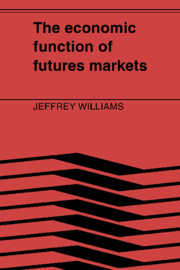Book contents
- Frontmatter
- Contents
- Preface
- 1 An introduction to futures markets
- 2 Equivalent ways to borrow and lend commodities
- 3 Futures markets and risk aversion
- 4 The demand to borrow commodities
- 5 The contribution of futures markets
- 6 The optimal number of futures markets
- 7 Conclusion: The economic function of futures markets
- Glossary of trade terms
- Reference list
- Index
6 - The optimal number of futures markets
Published online by Cambridge University Press: 06 October 2009
- Frontmatter
- Contents
- Preface
- 1 An introduction to futures markets
- 2 Equivalent ways to borrow and lend commodities
- 3 Futures markets and risk aversion
- 4 The demand to borrow commodities
- 5 The contribution of futures markets
- 6 The optimal number of futures markets
- 7 Conclusion: The economic function of futures markets
- Glossary of trade terms
- Reference list
- Index
Summary
Considering the significant advantages of functioning loan markets in commodities and the dominance of futures markets as the institution for providing such loan markets, one might wonder why organized futures markets are so few in number. There are probably no more than forty or fifty worldwide with sufficient volume to be deemed active markets. The number of exchanges, like the Chicago Board of Trade, is even smaller. Further, the same commodity is rarely actively traded on more than one exchange. The London Metal Exchange and Comex in New York do survive side by side, but because the LME closes just as Comex opens they do not compete directly. Likewise, the cocoa and coffee markets in London and New York, even though they trade different varieties, are more naturally considered as part of one worldwide market chasing daylight hours. In any case, for metals, cocoa, and coffee, either New York or London dominates, attracting the large majority of volume and open interest. Similarly, the markets for wheat in Kansas City and Minneapolis, which offer contracts for different varieties, are also small in comparison to the primary market on the Chicago Board of Trade. Otherwise, futures trading is overwhelmingly concentrated in one location for a particular commodity. In that one market trading is rarely in more than five or six delivery months, spanning a year or two.
The small number of active futures markets is perfectly reasonable. Few commodities have a pronounced term structure. That is to say, few have spreads sufficiently volatile to justify delivery months stretching far into the future. The same is true for one commodity in several locations and for the full multitude of delivery months within a calendar year.
- Type
- Chapter
- Information
- The Economic Function of Futures Markets , pp. 180 - 229Publisher: Cambridge University PressPrint publication year: 1986



